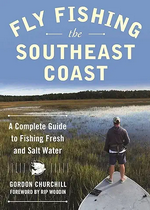1. Too much slack in the line when starting the back cast. The rod tip needs to be down close to the water to avoid slack accumulating as a raised rod forces the weighted fly line to strive to hang straight from the elevated tip to the water causing the fly line in the water to move toward where the line falls to the water from the rod tip. This may result in a pile of fly line in the water underneath your rod tip. All of this slack line means you have to raise the rod higher just to get the end of the line moving (after taking up all the slack) so you can start the back cast. By contrast, when you hold you rod point just inches off the water surface, you can strip in all the slack in the line and no more will accumulate before you start your back cast. You will not need to move the rod as much to get the fly line off the water so you can finish your hurry up & stop to finish the back cast.
2. The angler doesn’t wait for the back cast to roll out. You know you are doing this if you hear a sharp SNAP or POP like that of a bullwhip as you make your forward cast. You need to wait until the back cast has almost finished rolling out behind you before you begin your forward cast if you want the forward cast to behave properly.
3. The angler tries too hard to make the cast work. This is the kiss of death. Fly fishing is a gentle sport in that many movements start slow and the acceleration necessary before the complete stop of the rod that are necessary for a good cast is relatively short. Though Lefty Kreh does not like to use the word “power,” the “power” stroke in both the back cast and the forward cast are only a few inches long. Lefty speaks of the “hurry up and stop” instead of power. It is a subtle difference. But the cast will let you know how well you did. If the cast moves quickly and seems to “jump” into high gear, you have done it properly and the rod will unbend when stopped and the line will zoom out to the intended target, If you exert too much power, you will overpower the rod and the cast will result in a pile of fly line on the water.
4. Many anglers put a death grip on the fly rod handle. This invites disaster since it usually results in an attempt to power the cast instead of letting the rod and line do 95% of the work. Holding the rod handle gently will help prevent the exertion of too much power. On the back cast, two fingers are all you need to make it do well and on the forward cast, your thumb on the cork handle is doing all the work.
5. Anglers don’t “hurry up and stop” but try to power the cast. This is a variation of the theme of points 3 and 4. But here we will put emphasis on the STOP. STOP means STOP. It doesn’t mean slow down or stop and then crawl forward or backward. It means stop. This action allows the bent fly rod to release the energy it has been storing as we pulled the line from the water on the back cast and pulled the line forward for the forward cast.
6. When anglers move their forearm like a windshield wiper in semi-circular motion, the line is going to crash behind you on the back cast. On the forward cast, the line will follow a large arc that will allow the wind to tear it apart and the forward cast will land in a puddle. The correct motion is like you are using a squeegee with your forearm going back and forth in a straight line.
7. Anglers don’t keep the rod tip in the same plane. This wastes the energy of the cast and puts the rod in danger of being struck by the line, disrupting the cast and causing damage if the rod is hit by the fly and/or line that can result in a broken rod sooner or later.
8. Almost all anglers bend their wrist too much. But keeping your wrist straight is essential to having a tight loop that is efficient, controlled and accurate. Bending the wrist too much can cause the line to dump either behind or in front of the angler, destroying the cast- or both. In this regard, keep your thumb and the line guides on the rod aimed in the direction you want the line to go.



